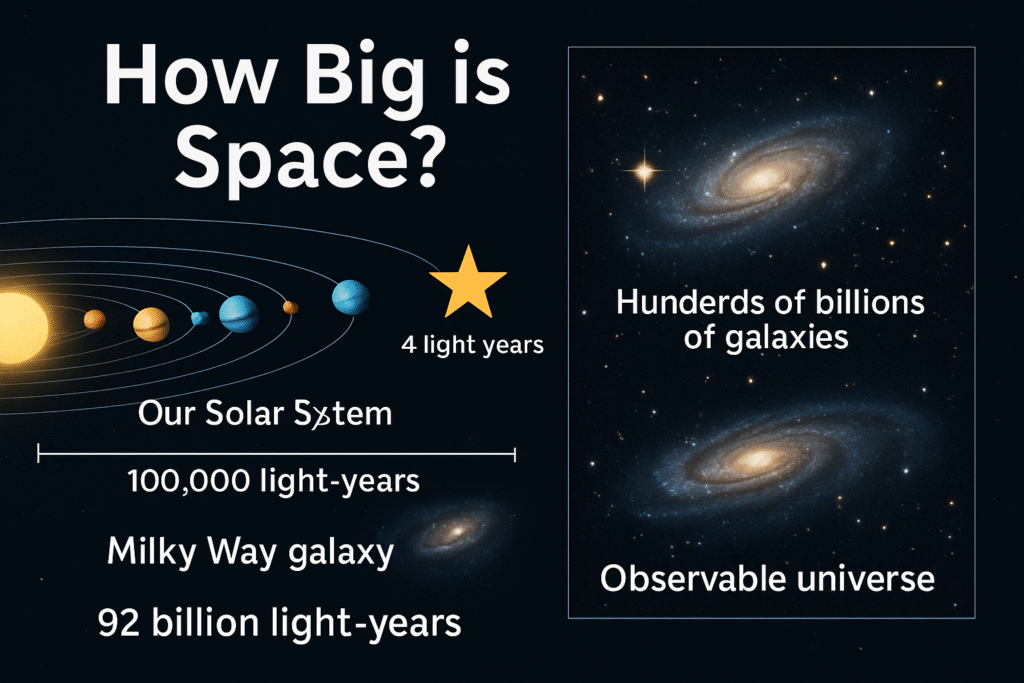Table of Contents

Introduction: Why Asking “How Big is Space?” Matters
When we ask “How Big is Space?”, we’re diving into one of the most fascinating and mind-bending questions in science. Space isn’t just big — it’s beyond comprehension. From our tiny blue planet to the furthest galaxies captured by telescopes like Hubble and James Webb, the scale of the universe challenges our imagination.
This article walks you step-by-step through the staggering dimensions of space: from our solar system to galaxies billions of light-years away.
Our Solar System: The First Step in Measuring How Big Space Really Is
To begin answering how big is space, let’s start close to home: our solar system.
Earth orbits the Sun at 93 million miles (150 million km). This seems manageable on a cosmic scale, but even traveling from Earth to the outer planets demonstrates how vast space is—even locally.
A Simple Example:
If you could drive to Pluto at 60 miles per hour, the journey would take about 6,000 years. That’s longer than recorded human civilization!
This puts the immensity of space into perspective—our own solar system already stretches the limits of human travel.
Why We Measure Space in Light-Years
Beyond our solar system, distances become incomprehensible using miles or kilometers. That’s why astronomers use light-years, the distance light travels in a year.
Quick Facts:
- Light travels at 186,000 miles per second.
- In a single year, light covers 6 trillion miles.
- Proxima Centauri, our closest star after the Sun, is 4 light-years away—about 24 trillion miles.
When we say “4 light-years”, we’re talking about light traveling non-stop for four years to reach us.
Using light-years helps simplify the otherwise mind-breaking numbers involved in understanding how big space truly is.
The Milky Way Galaxy: Our Vast Cosmic Home
To grasp the enormity of space, you must look beyond our solar system to our galaxy — The Milky Way.
The Scale of the Milky Way:
- Contains over 100 billion stars.
- Stretches approximately 100,000 light-years across.
- Our solar system sits roughly halfway between the galactic center and its outer edge.
Even traveling at light-speed (which no current human technology can achieve), it would take 100,000 years to cross the Milky Way.
This gives us a sense of how tiny Earth is within just one galaxy among potentially trillions.
Beyond the Milky Way: Countless Galaxies in Deep Space
The Milky Way is just one of many—scientists estimate hundreds of billions, if not a trillion galaxies populate the observable universe.
Thanks to the Hubble Space Telescope and the more powerful James Webb Space Telescope, we now understand:
- Each galaxy contains millions to billions of stars.
- Many stars host planets, gas clouds, dark matter, and possibly life.
Visualizing Scale:
Imagine every star like our Sun having planets. Multiply that by billions of stars per galaxy. Then multiply by billions of galaxies.
The answer to “how big is space?” becomes almost incomprehensible.
Time Travel Through Space: Seeing Billions of Years into the Past
Astronomers call light a cosmic time machine. Because light takes time to travel, looking far away means looking back in time.
Fascinating Fact:
The James Webb Space Telescope can detect galaxies whose light began traveling to us 13.5 billion years ago, soon after the Big Bang.
But because space itself is expanding, those galaxies are now much farther away than their light travel time suggests. This reveals more about how big space truly is and how much remains beyond our reach.
The Expanding Universe and the Observable Edge
So, how big is space right now?
The universe is still expanding. Distances between galaxies grow, even between those no longer sending us new light. This constant stretching complicates our understanding of space’s size.
Cosmologists estimate the observable universe is roughly 92 billion light-years across—this is the space from which light has reached us since the dawn of time.
Important Note:
This is just the observable universe—what light allows us to see. Beyond that? We have no way of knowing for certain.
Is Space Infinite? The Greatest Mystery of All
We can measure what’s observable, but we don’t yet know if the entire universe is finite or infinite.
Theories Scientists Explore:
- The universe could curve back on itself like a sphere.
- It might be infinitely flat, stretching forever.
- Or space could exist in dimensions beyond human understanding.
Until we advance technologically or philosophically, how big space truly is will remain one of science’s biggest mysteries.
Why Does Understanding How Big Space Is Matter?
Why should we care about how big is space?
The question shapes how we view our place in the cosmos.
Reasons It Matters:
✅ It puts life’s problems into cosmic perspective.
✅ It inspires curiosity and fuels technological breakthroughs.
✅ It deepens philosophical questions about existence, time, and life itself.
✅ It helps refine scientific models for space exploration, physics, and astronomy.
Asking “How big is space?” pushes the boundaries of what humans can imagine.
The Human Perspective: Small Yet Remarkable
Thinking about space’s scale can feel overwhelming. Earth becomes a tiny speck. Human history, a mere blink in cosmic time. Yet, it’s also incredibly inspiring.
Despite our smallness, we’ve:
- Built telescopes to see billions of years into the past.
- Sent probes beyond our solar system.
- Developed physics and mathematics capable of modeling galaxies.
That alone is an extraordinary achievement.
Conclusion: So, How Big is Space?
To sum it up clearly:
🚗 A drive to Pluto would take 6,000 years.
🌟 The nearest star is 4 light-years away.
💫 The Milky Way spans 100,000 light-years.
🌀 There may be a trillion galaxies.
🚀 The observable universe stretches 92 billion light-years across.
And beyond that? We simply don’t know.
What we do know:
Space is bigger than anything we can fully comprehend.
Yet our desire to explore it shows how extraordinary humanity really is.
1 thought on “How Big is Space? Exploring the Immense Scale of the Universe”